Trace: Six Grids and a Hypothesis
Mal Ahern
Part 1: Six Grids
First grid, 1877. A man mounts a horse, and urges it to gallop in a straight line. Two dozen thin wires stretch across the track ahead. Told to disregard these obstacles, man and horse proceed at a steady pace. Each wire tenses, then snaps, under the pressure of the horse’s unrelenting forward movement. It’s a simple directive: go forward. Merely by following it, man and horse helped generate a novel piece of information. Each wire triggered one of two-dozen cameras, and each camera captured a still image of man and horse in transit. The 24 photographs they produced appear quite similar. But when they are arranged into a grid, one aspect emerges as distinct in each photograph: the positioning of the horse’s legs. And two photographs, near the top of the grid, stand out from the others. They show that, for a split second in its forward gallop, the horse had all four of its legs off the ground. Artists, scientists, and equestrians had observed horses for centuries without knowing this fact. In all likelihood, the horses never knew it either, and still don’t.
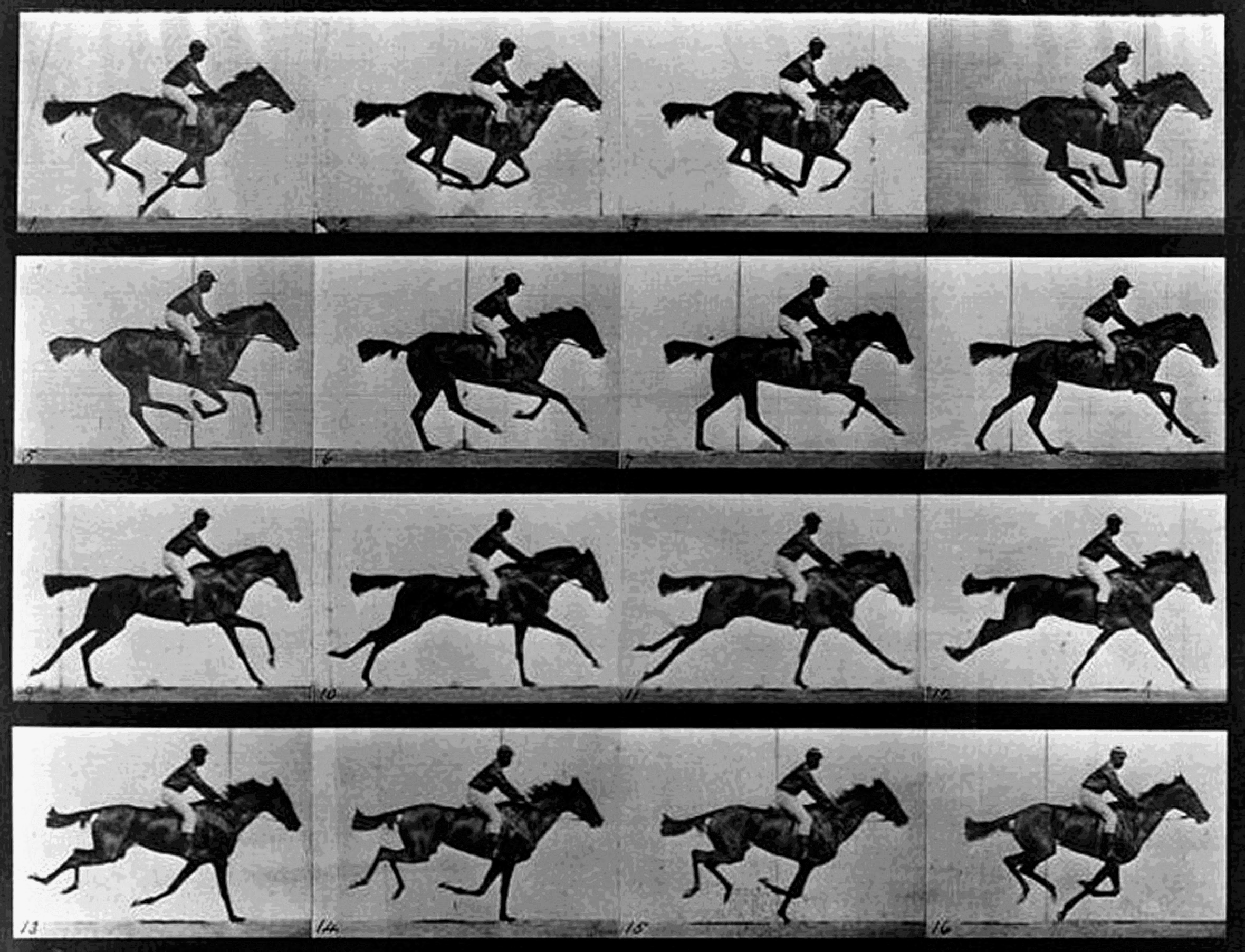
Eadweard Muybridge, Horse in Motion, ca. 1886.
Second grid, 2011. An art student grasps a pencil, takes a deep breath, and starts to draw a straight line. She moves her arm downwards, slowly and steadily, dragging her pencil along an expanse of white wall, with another assistant holding a ruler to guide her progress. The wall’s surface is slightly irregular: small bumps and pock marks urge the student’s pencil to jump from its course. Resisting these threats, she carefully modulates her pressure, her speed, her grip. She has one goal: to draw straight. She sticks to it. After reaching the far edge of the wall, she returns to her starting point and starts all over again, a half-inch to her right this time. Eventually, a fellow assistant arrives to relieve her from her task. Like his predecessor, he strives to adhere, as rigorously as possible, to the directions he has been given. When the group finishes its project, the wall holds a giant grid of regularly spaced, crisscrossed lines.
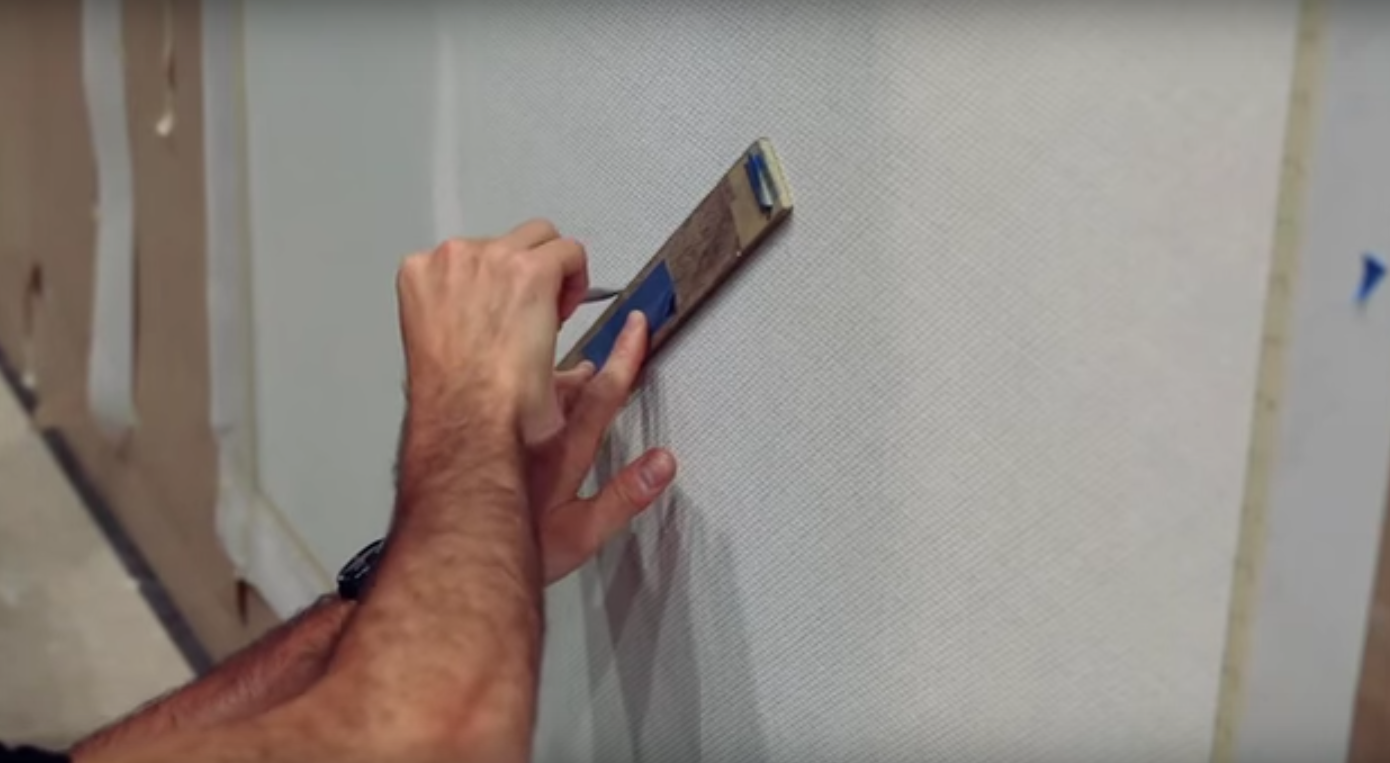
Still from the video “Installation of Sol LeWitt’s wall drawings at the Art Gallery of NSW,” Sydney, 2011.
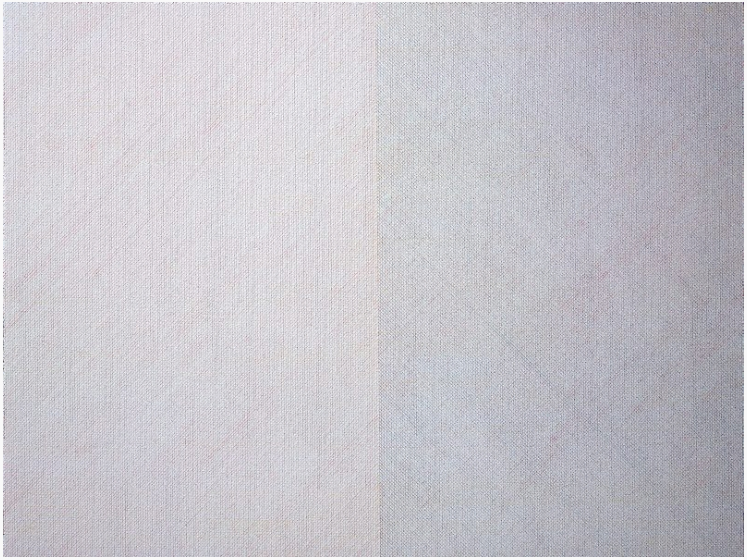
Detail of Sol LeWitt, Wall Drawing #337, 1971. Installed at the Art Gallery of NSW, Sydney, 2011.
Everyone tried their best to execute the directions they’d been given, as perfectly as possible. But the assistants who created the grid were, of course, only human. On close inspection, each line they drew includes slight variations in width and sharpness; many wobble slightly, or veer off-course. In another wall drawing, assistants were instructed to copy as nearly as possible a squiggling line that came before it. Over a flat, two-dimensional space, the temporal process of the work’s execution appears in each trembling line, and in their entropic progression. Viewed all at once, these lines combine to create dimensional figures, a pulsing image of both the procedure that created it, and the deviations from that procedure.
Third grid, 1964. It is hard to say whether Sol LeWitt had Eadweard Muybridge in mind when he first devised the Wall Drawings. LeWitt had explicitly and repeatedly alluded to the scientist-photographer in several works from the early 1960s, including the chronophotographic work Muybridge, from 1964.
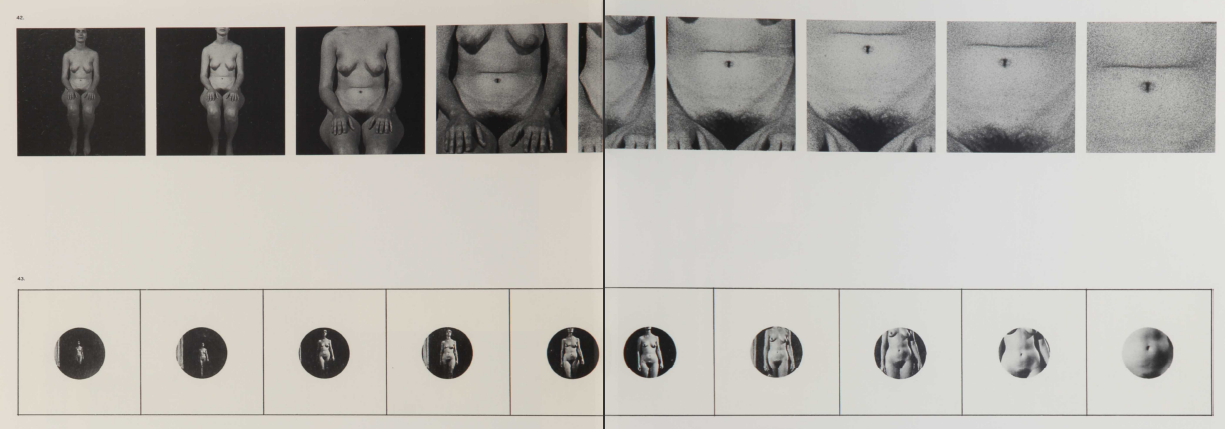
Sol LeWitt, Muybridge, 1964.
Perhaps more important than the issue of direct influence are the formal resonances between the two artists’ methods. Muybridge and LeWitt are both system-builders. Both create grids with iterative structures; both deploy studio assistants; both mix spectacle and scientific inquiry in their work. Both solicit performances that yield permanent material traces.
By putting living beings through a repetitive process of tracing lines, Muybridge made visible an aspect of equine movement that is so fleeting as to be typically imperceptible to human eyes. We cannot not see the fact of “unsupported transit” while a horse is moving. We cannot see it as a process, as fully integrated into the flow of time and the context of the horse’s movement. Instead, we are able to perceive it in the form of an object—as a plate of snapshots. By presenting dynamic process as static image, chronophotography slices through the fabric of space and time. It cuts up context, saves a few pieces of it, and radically decontextualizes them. It was this aspect of chronophotography that Henri Bergson famously found so disturbing; it is also this now very everyday act of cutting and reassembling context that we call “recording.”
The Wall Drawing is a recording, too. It materializes some aspects of the context of its emergence. Others, it hides.
Fourth and fifth grids, 1968-1969. Sol LeWitt created the first of his Wall Drawings at the Paula Cooper gallery in October 1968. He soon started hiring young artists to carry out these wall drawings according to his specific instructions. One of these artists was Adrian Piper, then a 21-year-old undergraduate at New York’s School of Visual Arts, who installed at least two of LeWitt’s Wall drawings over the course of 1969.1 She was already, at her young age, a good friend of LeWitt and an ambitious artist in the post-minimal and conceptual art scene; her importance to art history would only grow over subsequent decades.
Before installing LeWitt’s Wall Drawings, Piper created a series of works she called Hypothesis. Using a graph form with an X and Y axis, Piper mapped her spatial proximity to various inanimate objects over time. Using a camera, she performed the same mapping, taking photographs from her point of view. Sometimes, like Muybridge, she snapped photographs at regularly timed intervals; at others, she exposed photographs randomly, when the impulse struck her. One episode of Hypothesis sees her circumnavigate a chair. Another, which she made for Sol LeWitt and dedicated to him, shows her watching television.
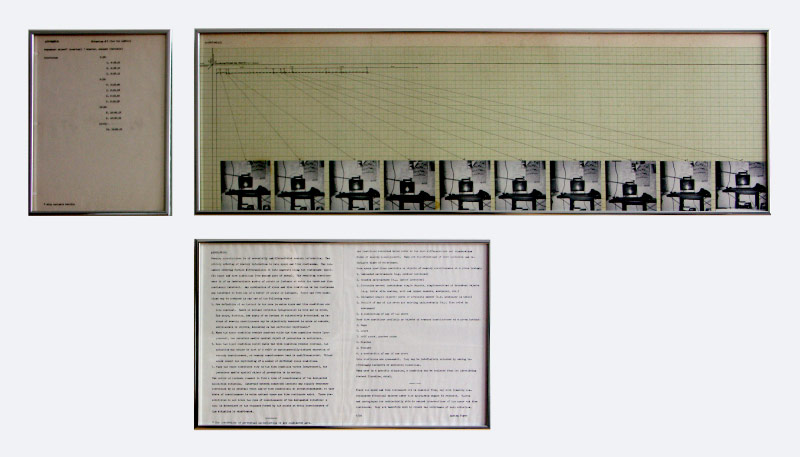
Adrian Piper, Hypothesis Situation #3 (for Sol LeWitt), 1968-1969.
Of this series, Piper wrote:
The photos were symbolic representations of the contents of my consciousness at a particular space-time location and moment. Then I plotted those moments on a space-time coordinate system. The horizontal graph is the time coordinate and the vertical graph is the space coordinate. The photos connect each moment with a particular space-time intersection. Each individual work is an artifact and document of my consciousness during a certain unique time interval.2
The result was not only a series of chronophotographs, similar to those by Muybridge, but also a grid of wavering lines. Piper’s graph plotted the relationship between a dynamic environment of material objects, and a living, breathing, perceiving being.
Not long after Piper dedicated this work to LeWitt, she helped him install several of his early Wall Drawings. Like Piper does in Hypothesis, LeWitt uses the abstract form of the grid to map the relationship between the material world and living beings. Were the artists who drew the grids capable of machine-like perfection, the tonality of the drawing would be equal—since, in LeWitt’s words, “there are an equal number of lines in each section. However,” the artist continued, “The properties of the wall in some cases dictate the darkness of the line… The pressure exerted by the draftsman is not always equal, nor is the distance between lines always the same, accounting for darker areas. These deviations… are inherent in the method.”3 That is, his grid was set up so as to capture these deviations. It was an abstraction, a set of ideas and procedures that, when rendered in material form, recorded contingent encounters between the particular texture of a wall’s surface, and the particular quality of an individual’s way of drawing a line. The wall drawing captured deviations from the plan. It also effaced the individuality of the artists who erred. It put difference on display without exposing individual subjectivity, which was subsumed by its illegible texture.
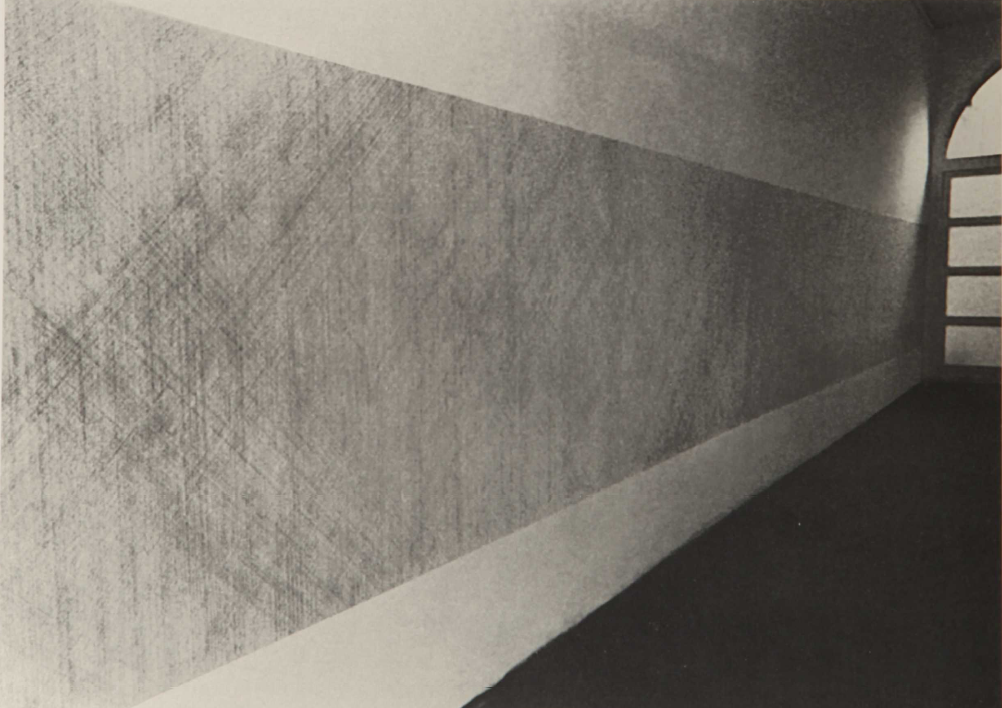
Sol LeWitt (with assistance from Jerry Orter and Adrian Piper), Wall Drawing #3, New York, May 1969.
Sixth grid, 1971. Piper’s own work went in a different direction after Hypothesis. As she started exploring her own subjective encounters with the world, she came to explore the unavoidable facts of the racism and sexism she faced daily. She was a young black woman who was often, due to her appearance, mistaken as white; in both majority-black and majority-white social environments, her presence activated chain reactions of recognition and misrecognition, of assumptions and inferences deeply embedded in the historical context of American racism.
In Hypothesis, and in LeWitt’s early Wall Drawing, Piper’s pencil traced a record of her physical presence in the world. Her movement in space and time was a cause; the lines she traced upon these grids, an effect. But the grid only indexed the effects of her physical presence physically. And Piper was keenly aware that her mere physical presence exerted social effects. The social fabric was as essential to her concept of being as the fabric of space and time. She came to see her own politically-charged body as a catalyst, and the world around her as reactive, as a substance she could activate through carefully planned interventions.4
But I’ll close this section with one last work of chronophotography, a project Piper called Food for the Spirit. In 1971, while working on her Ph.D. in philosophy at Harvard, she went into a period of isolation as she fasted, practiced yoga, and studied Immanuel Kant’s Critique of Pure Reason, which had, in her words, “obsessed” her. Years later, she wrote of this period, and of the artwork that resulted:
I rigged a camera with a tape recorder next to a mirror… so that every time the fear of losing myself overtook me and drove me to the ‘reality check’ of the mirror, I was able to both record my physical appearance objectively and also record myself on the tape repeating the passage in Critique that was currently driving me to self-transcendence.5
Piper’s very being faced two threatening abstractions: the philosophical tradition that would erase her blackness, and the racism that would reduce her to it. As the poet and theorist David Marriott has written, both of these abstractions represent “a dreadful and extremely intensive subtraction that Piper describes perfectly as a mirroring detached from any body, and in which one can see one’s own absence and/or threatened annihilation.”6 Worried that she would herself become an abstraction, she used recording devices to reassure herself of her body, of her contingent, physical being.
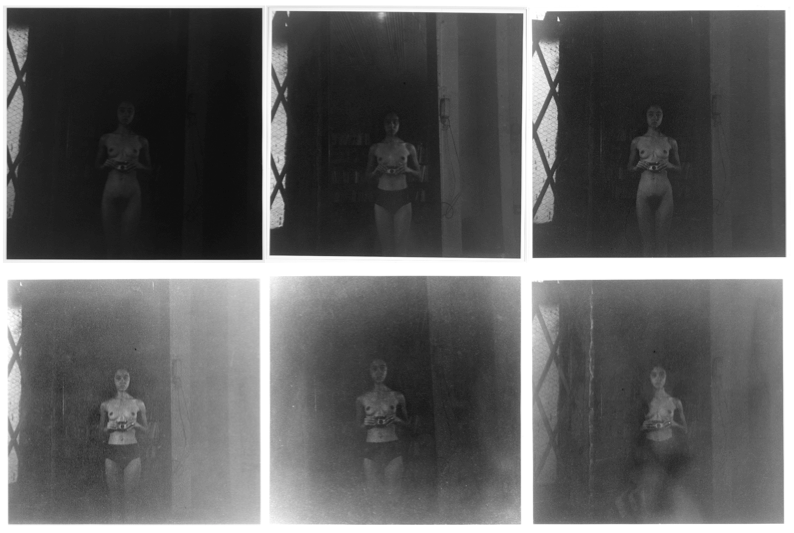
Adrian Piper, Stills from Food for the Spirit, 1971.
Yet the images that result are just as Marriott describes them: “mirroring detached from any body,” they are “a trace of a residual loss.” He continues:
What threatens the black autobiographical subject is not the loss of something that once was present and that it once possessed, but the radical estrangement between any representation and an imaginary fullness of being… The mirror image, then, has something to do with the repossession of the lost self, but this is a self that is alienated, distracted, and already possessed by a deeply invasive presence that has no phenomenal existence. Food for the Spirit attempts to capture that which is always concealed from representation: the withdrawal or remainder produced by the desire for universalization itself, which is to say, the desire to coincide with oneself as a subject.7
Put another way, any honest picture of Piper would have to include her estrangement and withdrawal in the face of modernity’s founding abstractions: the transcendental subject and the racialized body. Perhaps any honest picture of anyone would have to include these things. But then, pictures often lie.
Part 2: Interlude on a Device
Take another abstraction, another fiction: the perfectly straight line
If you draw a straight line in a geometry class, or while sketching a map for an out-of-town guest, or in most everyday situations, the resulting shape will signal straightness and line-ness, even if it is not perfectly straight. In cybernetic terms, the “noise” to this signal is what we must ignore and suppress in order to see straight line-ness: wavering, curves, changes in width or tone, breaks in continuity, etc. But if straight-line-ness is a given, the relation between signal and noise is flipped. Line-ness becomes an abstraction we take for granted. The divergences we’d otherwise suppress as “noise” emerge, instead, as signal. Rather than communicate “straight-line-ness,” the line becomes an information-bearing medium. It indexes not the intention of the hand that drew it, but its wavering off course.
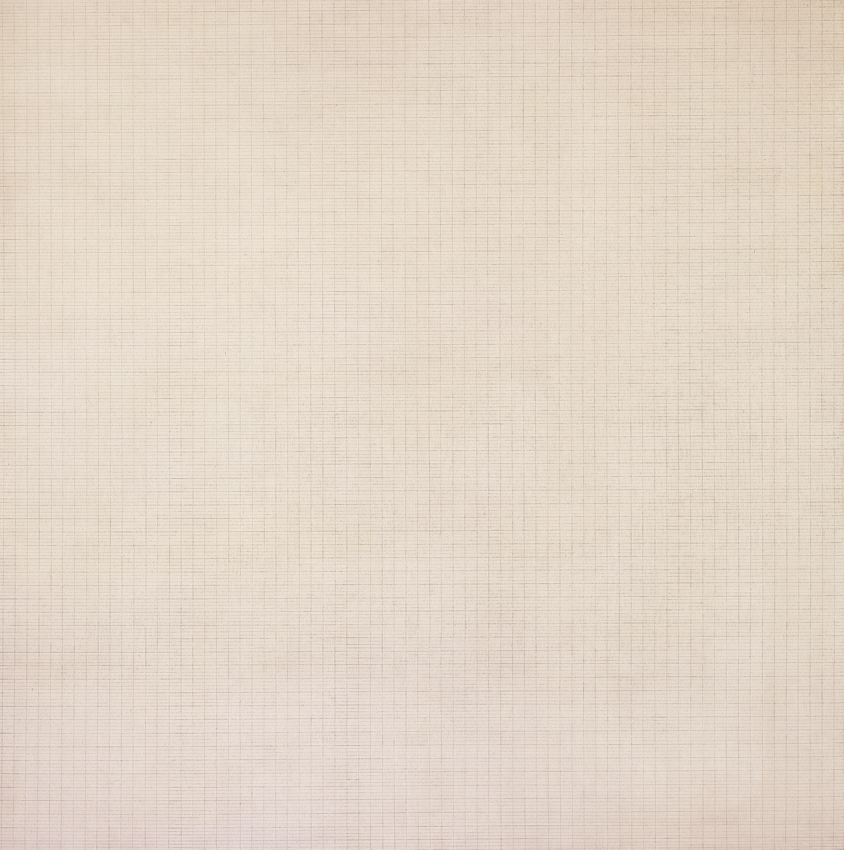
Agnes Martin, Leaf, 1965.
A seventh grid, created by Agnes Martin in 1965, makes this clear. Martin’s grids—drawn in graphite or ink, often over white and colored wash—are startling in their near-perfection. Her lines evoke the immaterial abstraction of the grid, and yet record the material contingency of the hand-drawn line in minute detail. In Leaf, Martin’s lines appear perfectly straight, yet her gestural presence appears in subtle changes in tonality that index the changing pressure of her hand. The art historian Briony Fer has suggested that Martin uses the grid to calculate “incalculable, infinite differences.”8 That is, by drawing the same line over and over again, Martin generates differences. In Fer’s words, the resulting formal repetition “ensures some regulating pattern of recognition,” that is, ensures that we can recognize difference on such a minute scale.9
In the years after 1968, LeWitt’s Wall Drawings would move past the model of them I propose here. They soon became more game-like and suggestive, offering the draftsperson chances to interpret the instructions or choose among variables they offered. Others offered the wall’s mute architecture the chance to express its own constraints. Later wall drawings would become still more exact, with bolder lines and shiny, colored surfaces designed for maximum graphic impact.
Yet the early Wall Drawing LeWitt generated with Piper and Orter—its smudged, illegible presence so distinct from Martin’s delicate construction—similarly engineers a reversal of signal and noise, difference and repetition. LeWitt urged his studio assistants follow directions as closely as possible: to attempt to make their lines straight and true, to space them evenly, and to do their best to keep the tone of each line regular. Yet he acknowledged with some enthusiasm that it was impossible for human hands to reproduce a grid with mechanical accuracy. “Each person draws a line differently,” he wrote. “All wall drawings contain errors. They are part of the work.”10 The grid also makes visible the often imperceptible texture of the walls it decorates: “Most walls,” LeWitt admitted, “have holes, cracks, bumps, grease marks, are not level or square, and have various architectural eccentricities.”11 All surfaces have textures that bear on every material instantiation of any flat image; the hand-drawn grid records the contingent presence of these textures.
Ask artists to draw perfectly straight lines—with imperfect hands, on imperfect surfaces—and small flaws will emerge from the collision between abstraction, surface, and living being. These flaws create a sub-pattern within the broader pattern—an image of presence and movement generated as if by accident. The Wall Drawings thus visualize a biological register of being, and of doing, that is independent of intention.
Here I will state clearly something I have until now only implied: I consider the hand-drawn grid to operate much like a camera. Both are what I would like to call “recording devices.” LeWitt’s early Wall Drawings deployed the abstraction of a grid and the texture of a wall surface to capture the contingencies of human gesture. The camera does the same thing, using the abstractions of optics and chemistry: the curved shape of the lens and the textured grain of a photosensitive surface. Over the centuries of its existence the camera has collected layers of historical, cultural, and technological sedimentation, and those of us who study cameras mostly focus on those layers. But the camera is also a form. It is any aperture that gathers light and projects it into darkness. A plan for a Wall Drawing is a set of formal rules that await execution; so is a camera. A Wall Drawing is an execution of rules that visualizes contingent encounters. So is the photograph a camera yields.
A recording device, then, need not be a physical machine. It can also be a set of directions. In order to record, the device must stage an encounter between abstract form and contingent matter. Not any such encounter will do, however: the procedure must be reliably repeatable enough, and the abstract form rigorous enough, to yield reliable results. The recording device deploys rule-based and repetitive processes in order to create a scenario similar to the set of controls that isolate variables in scientific studies. That is, it repeats a procedure again and again according to a set of formal rules. A camera only records reliably if its abstractions work predictably; likewise, the Wall Drawing only records reliably if its draftsperson sticks to its plan unwaveringly. To record requires repeating; indeed, before the emergence of mass media, to record something was to memorize and recite it.12 Repetition is the soul of the device.
To “record,” then, is not to “capture” a part of “reality.” Instead, to record is to remove one element of chance from the densely woven fabric of contingency we call “the world.” Recordings do not stand outside the world and report on it from an objective distance; recording devices are not simply mechanisms for recording something. Devices are equally a part of the world. Through repetition, they intervene in the world’s dynamic processes. It is through their lack of dynamism, their rigid repetitive forms, that recording devices create disruptions in balanced systems.13 These disruptions generate objects that give sensual form to some dynamic processes, while hiding others. Both the Wall Drawing and the Motion Study emerge from the encounter between a directive—“go straight”—and the creature who executes it, as well as the surrounding environment. This encounter, moreover, is embedded in complex networks of influence and entanglement. A horse’s gait or an artist’s gesture might change with a mood or the weather or the time of day; those events generate images that are equally influenced by the incident of light or the texture of the recording surface. Both LeWitt and Muybridge create devices which they embed deeply in a dynamic set of relations, and which generate permanent material records that emerge from those uncountable relations.
Upon obtaining that material record, the recording device removes it from the context that created it. Decontextualized and made image, the record can travel through space and time. The photographic plate travels around the world; the Wall Drawing stands still long after the assistants who drew it moved on. In a way, this is the story of all recording media. A recording device insinuates itself in a relational dynamic, then creates objects that stand outside of that dynamic. A recording is a decontextualization. It is a cut in context.
Part 3: A Hypothesis
Every recording device makes cuts in a context. Each recording medium has its own “mediacy,” its own particular way of corrupting the flows of space, time, and causality. Each medium is unhappy in its own way. Immediacies, like happy families, are all alike. Like happy families, too, they might not exist.14
I will conclude by suggesting that it is the shape and ambition of these cuts in context that allow us to see, or not see, an object or phenomenon as “recorded.” The main reason we don’t recognize grid-drawing as a recording device is that objects and events are hard to see in grids. We cannot reduce the wavering form of each of Agnes Martin’s lines to a form of evidence, to the effect of a determinate cause. We cannot look at a tiny swerve or gap in one of her lines and say for sure why it exists. This cut in context excises too little; too many imagined influences can bear on each line.
Likewise, LeWitt’s early Wall Drawing does not give us information about the individual who produced it. We are left with a useless representation of a biological register of being, of physical flux and pulsing; a record of human presence, but not a representation of it. The wall drawings record individual presence without providing an image of individuality; they visualize a biological register of being without proposing any generalizable meaning or idea about that being. They emphasize, instead, the difficulty we have reducing human movement to mere abstraction, the individual’s failure to comport with the abstract motions technological modernity requires of her, and the ultimate illegibility of so many traces.
Muybridge’s recording device aims to do just the opposite of this. In his chronophotography, he sought to taxonomize movement on a species level, to create racial and sexual typologies of movement, and to make that movement legible. The images he produced anticipated the industrial time and motion studies of Frank and Lillian Gilbreth, who used recording devices to analyze and rationalize movement in hopes of extracting its maximum labor power. We might, then, consider chronophotography to be LeWitt’s sinister twin. If LeWitt underdetermines, Muybridge overdetermines. He cuts out myriad influences in order to produce a legible picture. At the cost of this cutting comes the promise of proof: the promise that the photograph will introduce new facts into the world. The irony, when it comes to Muybridge, is that his images are too legible to fully inform us. They fail to show us what they do not include. As the photohistorian Marta Braun observes in her study of Étienne Jules-Marey, Muybridge was unable to capture the pace of the movements he recorded due to the fact that he used spatial, rather than temporal, cues to trigger his exposures.15 His images imply the passage of time, but they do not record it.
I have waited until now to bring Adrian Piper’s work back into the discussion. This is because Food for the Spirit, according to Marriott’s powerful analysis of it, “attempts to capture that which is always concealed from representation.” For Marriott, this is the incapacity of representation, the incapacity of Kant’s universalism and of racial taxonomies to describe, and our inability to represent, the aspects of being those abstractions fail to capture. The recording device literalizes this incapacity. It only represents because of its incapacity, because of its failure to match the flow and density of the world it tries to picture. Piper’s photographs of her reflection capture this incapacity—they hypothesize that, to borrow words from the anthropologist Paul Kockelman, “the essence of a mirror is not that you can see yourself in it, but that you cannot see behind it.”16 The essence of recording media lies not in their transparency, but in their myriad opacities.
This is perhaps why, as Roland Barthes observes, there is something in the photograph that is always uncoded, and maddeningly so. To take down a record in a world it is a part of, the recording device must cut. In doing so, it creates objects made of holes and gaps and blockages. We should not pass over these blanks, convinced the message lies between them. Our work is to find the void in each image, and to look in.
Notes
Mal Ahern is a Ph.D. Candidate in the Department of History of Art and the Program in Film & Media Studies at Yale University. Her work explores the tensions between visual signification, abstraction, and image-making technologies. Her dissertation, Form and Device: The Structure of the Technical Image, 1960-1975, proposes a new set of terms for describing the relationship between media technology and aesthetic forms in the 1960s and 1970s. She has previously published essays in The New Inquiry, The Nation, and Millennium Film Journal.
For comments on earlier versions of this essay I heartily thank Francesco Casetti, Paul Kockelman, Mark Rodgers, Laura Wexler, and the editors of World Picture, particularly Meghan Sutherland. I have presented materials related to this work at World Picture Conference (Toronto, 2015), the Program in Film and Media Studies at Yale University (New Haven, 2016), and the [image here] conference at Harvard University (Cambridge, 2016), where I received valuable audience feedback. At those events, Nicholas Forster, Leah Pires, and Kenny Berger offered especially useful and memorable comments.
The first Wall Drawing is catalogued as Wall Drawing #1, Series II 14 (A&B). In May 1969, Adrian Piper and Jerry Orter assisted Sol LeWitt with the installation of his Wall Drawing #3 and Wall Drawing #11, both at the Paula Cooper Gallery; in September of that year, Piper alone installed LeWitt’s Wall Drawing #24 at the Dwan Gallery. Gary Garrels, ed., Sol LeWitt: A Retrospective (San Francisco: San Francisco Museum of Modern Art and New Haven: Yale University Press, 2000), 37 & 404. See also Massachusetts Museum of Contemporary Art, exhibition label for Sol LeWitt, Wall Drawing #11. Web, http://massmoca.org/event/walldrawing11/ (Accessed May 2016).
Adrian Piper, “About the Hypothesis Series,” Out of Order, Out of Sight, Volume I: Selected Writings in Meta-Art, 1968-1992 (Cambridge, MA: The MIT Press, 1996), 19.
This text comes from a set of hand-written instructions LeWitt created for Wall Drawing #3. Sol LeWitt, “Diagonal Lines in Two Directions, Superimposed (Plan for Wall Drawing, Paula Cooper Gallery, New York),” 1969. Reproduced in Garrels, 167.
I refer here to Catalysis, a series of street performances Piper did in the early 1970s in which she “tested people’s xenophobia and intolerance by transforming herself in odd or repulsive ways while engaged in everyday situations such as riding the subway or browsing a bookstore in clothes saturated with vinegar, eggs, and cod-liver oil,” for example, or shopping at a department store while covered in wet paint. Adrian Berger in Adrian Piper: A Retrospective (Baltimore: University of Maryland Fine Arts Gallery, 1999), 17.
Adrian Piper, “Food for the Spirit,” High Performance 4, no. 1 (Spring 1981). Reprinted in Out of Order, Out of Sight, 55.
David Marriott, “On Racial Etiquette: Adrian Piper’s My Calling (Cards),” Postmodern Culture 4, no. 1 (September 2013). Project MUSE, Web, http://muse.jhu.edu/article/567224 (Accessed May 2016).
Ibid.
Briony Fer, The Infinite Line: Re-Making Art After Modernism (New Haven: Yale University Press, 2004), 53.
Ibid, 58.
Sol LeWitt, “Doing Wall Drawings,” from Art Now: New York 3, no. 3 (June 1971): no pagination.
Sol LeWitt, “Wall Drawings,” from Sol LeWitt (New York: The Museum of Modern Art, 1978), 169.
“record, v.1,” OED Online. March 2016. Oxford University Press. http://www.oed.com/view/Entry/159868 (accessed May 13, 2016).
In terms drawn from systems theory, we might say that the traditional recording device lacks a feedback mechanism. It is blind to its own outputs, and to the effects its outputs have on its surrounding environment.
I said something like this previously in a very short piece called “Friend Time,” published in The Politics of Friendship, edited by Anicka Yi, Jordan Lord, Lise Soskolne, and Carissa Rodriguez (Zürich, Studiolo, 2013), no pagination.
Muybridge also evidently edited many of his sequences so as to produce a more legible effect. Marta Braun, Picturing Time: The Work of Étienne Jules-Marey (Chicago: University of Chicago Press, 1994), xvi-xx.
Paul Kockelman, “The Ground, the Ground, the Ground, or: Why Archeology is So Hard,” Yearbook of Comparative Literature 58 (2012): 176.